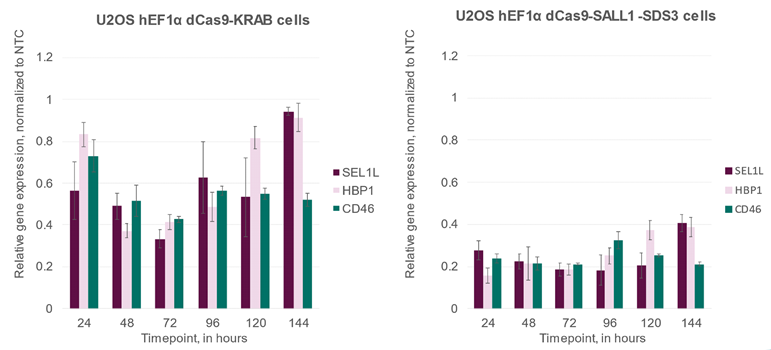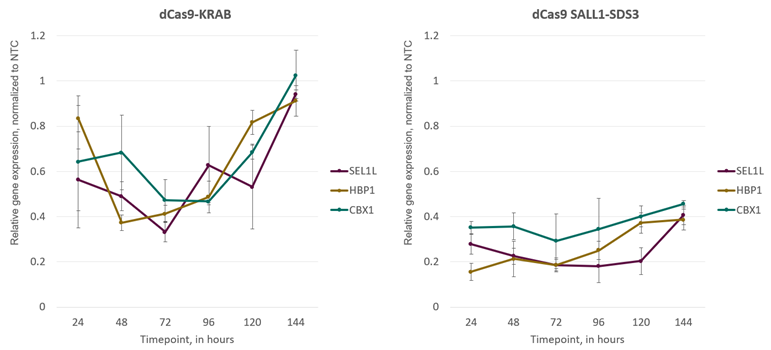CRISPR interference (CRISPRi) allows researchers to down-regulate specific gene function by blocking transcription, without editing the DNA. Visit our CRISPRi applications page to learn more.
The Horizon CRISPRmod CRISPRi system requires two components to operate: a gene-specific CRISPRi guide RNA and a catalytically deactivated Cas9 (dCas9) fused to transcriptional repressor domains (SALL1 and SDS3). Our CRISPRi reagents provide a straightforward, efficient set of tools to study a gene’s function via transcriptional repression.
CRISPRi reagent selection
There are many options and considerations for CRISPRi experimental conditions. For extended timepoint assays (more than 120 hours), we recommend lentiviral sgRNA. For short-term assays, synthetic sgRNA typically provides more robust gene repression.
| CRISPRi dCas9-SALL1-SDS3 source | Guide RNA format | Delivery method | Benefits & Recommended uses |
|---|---|---|---|
|
CRISPRi dCas9-SALL1-SDS3 lentiviral particle |
CRISPRi synthetic sgRNA | Transfection or electroporation |
|
| CRISPRi lentiviral sgRNA | Transduction |
|
|
| CRISPRi dCas9-SALL1-SDS3 mRNA | CRISPRi synthetic sgRNA | Co-transfection or electroporation |
|
| CRISPRi all-in-one dCas9-SALL1-SDS3 + sgRNA | Transduction |
|
|
Order CRISPRi guide RNA
CRISPRi synthetic sgRNA
The most rapid CRISPRi system, with repression within 24 hours post-transfection.
CRISPRi lentiviral sgRNA
An ideal delivery method for CRISPRi in difficult-to-transfect cells, or for longer term repression.
CRISPRi All-in-one Lentiviral sgRNA
Single reagent – dCas9-SALL1-SDS3 + sgRNA in one vector for easy gene to cell delivery.
CRISPRi dCas9 solutions
dCas9-SALL1-SDS3 mRNA
Co-transfect with synthetic sgRNA for transient CRISPRi in lentiviral-free workflows.
dCas9-SALL1-SDS3 lentiviral particles
Create a stable dCas9 expressing cell line, ready for CRISPRi studies.

CRISPRi gene repression is observed 24 hours post-transfection and is maximal 48-72 hours post transfection

CRISPRi gene repression is observed 24 hours post-transfection and is maximal 48-72 hours post transfection

CRISPRi lentiviral sgRNA is well suited for long term repression
CRISPRi synthetic guide RNA
-
CRISPRi synthetic sgRNA
The most rapid CRISPRi system, with repression within 24 hours post-transfection. Synthetic RNAs are modified for nuclease resistance and available as pooled or individual reagents.
-
CRISPRi synthetic sgRNA positive controls
Control sgRNAs targeting well-characterized genes to determine the effectiveness of your experimental conditions
-
CRISPRi synthetic sgRNA non-targeting controls
Non-targeting controls to evaluate baseline cellular responses to CRISPRi components in the absence of target-specific crRNA
CRISPRi lentiviral guide RNA
-
CRISPRi lentiviral sgRNA
Lentiviral particles of vector-based single guide RNA are predesigned for genome-wide coverage of human genes
-
CRISPRi lentiviral sgRNA positive controls
Control sgRNAs targeting well-characterized genes to determine the effectiveness of your experimental conditions
-
CRISPRi lentiviral sgRNA non-targeting controls
Non-targeting controls to evaluate baseline cellular responses to CRISPRi components in the absence of target-specific sgRNA
CRISPRi dCas9-SALL1-SDS3
Nuclease-deactivated Cas9, fused to our proprietary transcriptional repressor domains (SALL1 and SDS3).
-
CRISPRi dCas9-SALL1-SDS3 mRNA
Co-transfect with synthetic sgRNA using Dharmafect transfection reagents for transient dCas9-SALL1-SDS3 expression in lentiviral-free workflows.
-
CRISPRi dCas9-SALL1-SDS3 lentiviral particles
Create a stable dCas9-SALL1-SDS3 expressing cell line, ready for CRISPRi studies.
CRISPRi screening libraries
-
Custom cherry-pick libraries
Upload your own gene list to customize and order plates of predesigned sgRNA for CRISPRi studies across tens or thousands of genes
Horizon's CRISPRi workflows
We offer multiple workflow options when using CRISPRi for transcriptional repression
- Transduce with dCas9-SALL1-SDS3 lentiviral particles to generate CRISPRi-ready, stable dCas9-SALL1-SDS3 expressing cells. Then introduce either A) synthetic or B) lentiviral sgRNA to knockdown your target gene(s). This system is ideal for screening, extended time point assays or when working with difficult-to-transfect cell types.
- C) Co-transfect or electroporate dCas9-SALL1-SDS3 mRNA with synthetic sgRNA, then enrich cell populations using fluorescence or puromycin resistance options. This system is best suited for rapid, transient gene repression studies.

CRISPRi workflows
